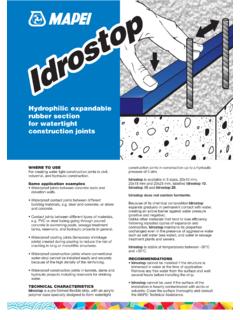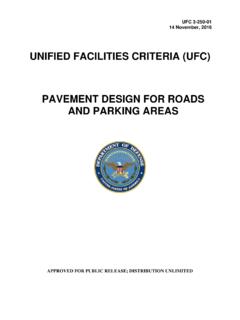Transcription of CONCRETE BLOCK PAVING - mvabricks.co.za
1 CONCRETEBLOCK PAVINGA walk-over in cost, looks anddurability for CONCRETE BLOCK PavingBook 2 Design AspectsConcrete BLOCK PavingBook 2: Design AspectsPublished by the CONCRETE Manufacturers AssociationPortland Park, Old Pretoria Road, Halfway House Box 168, Halfway House, 1685 Telephone +27 11 805 6742 Fax +27 11 315 4683e-mail Site: edition 2004 Portland Park, Old Pretoria Road, Halfway House 1685, South Box 168 Halfway House 1685 Tel +27 11 805 6742, Fax +27 11 315 4683e-mail: website: (016) Special Products Kenya (09254) (2)824-478 Baybrick(035) 791-1256 Bosun Brick*(011) 310-1161 Brickbuild Botswana(09267) 241-4089 Brick & CONCRETE Industries Namibia(09264) (61) 280-4103 Brickcast Industries*(031) 507-7094 Cape Brick(012) 511-2006 Cast Industries*(011) PAVING Products(021) 905-5998 Columbia DBL*(021) 905-1665 Concor Technicrete*(011) 495-2200 Consteen(011) 701-3875 Corobrik*(031) 560-3911 Deranco Blocks*(041) 463-3338 Ecco-Euro PAVING (011) 786-3109 False Bay Bricks(021) 904-1620 Infraset*(012) 652-0000(031) 705-2323 Inca Masonry Products*(043) 745-1215 Kwena Brickforce Botswana(09267) 322-850 Mimosa(016) 362-0507 MVA Bricks*(012) 386-0050 Neat Contech*(046) 648-1359 Stanger Brick & Tile*(032) 457-0237 Vanstone*(012)
2 541-2056 Vibro Bricks*(012) 374-2032 White River Cement Bricks(013) 750-1271 Brick King & Associates(021) 948-6218 Inca (Cape)(021) 904-1620 Daron Construction(034) 955-1333 Kay Crete(031) 765-2830 Oryan Projects(083) 327-6877 Pave Show(012) 346-6958 PYW PAVING (031) 903-2104 Roadstone Civil & PAVING (083) 266-3183SA PAVING , Gauteng(011) 483-1350 Sun PAVING (031) 705-5123 The PAVING Syndicate(011) 640-3333 Valcal International(011) 867-2771 Vesles Civils(012) 662-3030*Companies which hold the SABS markPAVING MEMBERS (SEPTEMBER 2004)PRODUCER MEMBERSPAVING MEMBERS (SEPTEMBER 2004)PRODUCER MEMBERSNON-PRODUCER MEMBERSCONTRACTOR MEMBERSNON-PRODUCER MEMBERSCONTRACTOR MEMBERSCONCRETEBLOCK PAVINGCONCRETEBLOCK PAVINGCONCRETEBLOCK PAVINGA walk-over in cost, looks anddurability for CONCRETE BLOCK PavingCONCRETEBLOCK PAVINGBook 2 Design AspectsCONCRETEBLOCK PAVINGCONCRETEBLOCK PAVINGP ortland Park, Old Pretoria Road, Halfway House 1685, South Box 168 Halfway House 1685 Tel +27 11 805 6742, Fax +27 11 315 4683e-mail: website.
3 Walk-over in cost, looks anddurability for CONCRETE BLOCK PavingA walk-over in cost, looks anddurability for CONCRETE BLOCK PavingA walk-over in cost, looks anddurability for CONCRETE BLOCK PavingA walk-over in cost, looks anddurability for CONCRETE BLOCK PavingA walk-over in cost, looks anddurability for CONCRETE BLOCK PavingBook 1 IntroductionBook 3 Specification & InstallationBook 4 Site management and layingBook 5 Training ManualBook 6 Facilitators Guide1 CONTENTSCONTENTS1. INTRODUCTION2. KEY ELEMENTS OF Bedding sand CONCRETE PAVING Jointing Edge Drainage43. STRUCTURAL DESIGN OF Equivalent thickness Catalogue design Research-based Mechanistic design Lockpave84. PRELIMINARY DESIGN Preliminary Construction95. SPECIAL Construction of steep Roof decks106.
4 Jointing Weed Reinstatement of Oil Stains117. CONCLUSION118. CASE Richards Bay Pinetown Traffic Bellville Goods Trident Steel Maxmead Johannesburg Northern Wastewater Treatment Pietersburg Traffic Analysis of a CONCRETE Segmental Road Pavement169. REFERENCES162 INTRODUCTIONC oncrete BLOCK PAVING (cbp), if properly designed andconstructed, will last for decades with little or nomaintenance being necessary. However, as with alltypes of pavements and structures, there are certainrequirements regarding the design and construction,which are important to the success of cbp. Thispublication covers some of these aspects, which arecritical to the successful long-term performance ofsegmented PAVING . History of the design philosophy isalso structural design of pavements is concerned withtraffic, layerwork (foundations), materials, subgradesoils, environmental conditions, construction detailsand economics.
5 Essentially the pavement must carrythe traffic at an acceptable level of comfort and safetyand at an acceptable cost. This is achieved by alayered structure where each layer has sufficientstrength to cope with the induced stresses withoutdistress such as rutting, excessive settlement ordeflection. Figure 2 shows how the pressure exertedby traffic dissipates under the the surfacing is subjected to the higheststresses, the effect of traffic (especially heavy traffic)is felt deep into the pavement layers, sometimes up toa metre deep. The strength of these layers is asimportant to the long-term performance of thepavement as the surface PAVING blocks not only provide a durablewearing surface, but also provide a structuralcomponent and hence contribute to the strength of thepavement.
6 They reduce the stresses in the layersbelow. Not all pavement requirements are equal, andevery pavement should be designed and constructed tosuit the particular KEY ELEMENTSOF PAVINGThe seven key elements of PAVING are:The subgrade or natural earth material found on siteThe subbase, a layer of road building materialimported when subgrade conditions are poor and/ortraffic conditions are thin layer of selectively graded bedding sandThe CONCRETE PAVING blocks, which form the basecourse as well as the surface wearing courseThe jointing sand that fills the gaps between everyadjacent blockEdge restraints, positive support placed around theperimeter of the pavementDrainage, both surface and subsoil, preventing thebuild-up of water in the pavement SUBGRADEAll structures-buildings, roads and other surfacedareas-are ultimately supported by soil or rock.
7 It is thedesigner s responsibility to evaluate the behaviour andperformance requirements of the structure to ensuresuch requirements are compatible with the soilconditions prevailing on the site. Subgrade preparationshould extend to the rear face of all new SUBBASEW here the subgrade is of a low strength, or the trafficis heavy, an imported subbase layer (or two or morelayers) may be required or treatment of the subgradeeg stabilised. The principles of design of the pavementlayers are the same as for most flexible the blocks perform a structural function, therequirements for the layerworks are less than forasphalt. In many cases the subbase course can the subbase is an unbound granular layer, it mayin some cases be advisable to seal the surface if it isfelt that, during the early life of the pavement, aFigure 2: Dissipation of traffic 1: Key elements of (consisting of blocks)SubgradeSubbaseSand bedding layerConcrete bedding & backingFootpathRoadwayKerbPaving blockJointing sandINTRODUCTION2 KEY ELEMENTSOF PAVING3danger of water filtering through the joints and intothe subgrade exists.
8 Sealing can be achieved byspraying a low-durability bitumen emulsion at a rate ofapproximately 0,2l/m . This is generally only atemporary problem, since the joints between the unitseventually become clogged with road detritus andimpermeable to BEDDING SAND LAYERThis is a thin (25mm 10mm after compaction)layer usually of coarse river sand. The purpose ofthis layer is to provide an even bedding for theblocks. The bedding sand is laid loose and the blockscompacted into this layer with sand rising in thejoints between blocks. This ensures that the blocksachieve an even , commercial clean river sand is sand may be suitable but needs to beevaluated for bedding sand pushed up into the joints betweenthe blocks ensures adequate joint width and results ininterlock when the joints are completely filled withjointing sand.
9 The bedding sand layer should be thin,clean, free of silt and should not be used as a levellingcourse to fill voids in the subbase surface. This willlead to subsequent CONCRETE PAVING BLOCKST here are a number of aspects of PAVING blockswhich should be considered during the design stage,namely the strength, shape, thickness anddimensional PAVING blocks generally have an averagecompressive strength of 25 MPa wet strength (Class25 SANS1058) . This is significantly higher than thestrength of bricks (7 MPa). The reason for this is toensure that the blocks have adequate resistance totraffic loading and to abrasion from traffic, bothvehicular and pedestrian. Research carried out byCSIR Road Research shows that for strengths inexcess of 25 MPa, little structural advantage is gainedby increasing strength.
10 It is also important to notethat although the required average strength is 25 MPa, the minimum strength for individual blocks is 20 MPa. Very often it will be this lower figure that willdictate the average strength for compliance withClass 25 blocks. Where the quality control is poor it isvirtually impossible to satisfy this latter SHAPEC oncrete PAVING blocks can be divided into three typesbased on shape (see Figures 3a, 3b and 3c).Research shows that type S-A blocks develop the bestresistance to both vertical and horizontal creep andare generally recommended for all industrial and heavy-duty applications. Type S-B and S-C blocks aregenerally selected for aesthetic BLOCK thicknesses vary between 50 80 mm. Thethicker the blocks the better the pavement will resistvertical deformation and horizontal creep.






